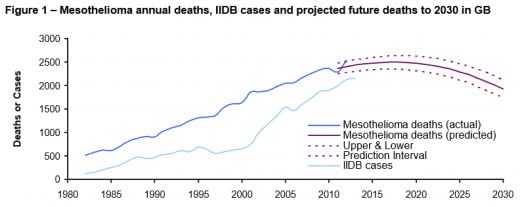School Insurance Premiums Set to Rise as Government Asbestos Review Released
Despite being banned in November 1999, hundreds of British schools still contain asbestos containing materials (ACMs) and the Government report into asbestos in schools will undoubtedly force UK insurers to reassess how the underwrite liability products sold to the education sector. Around 5000 people a year die from asbestos related diseases every year according to the UK Health & Safety Executive and 228 were teachers between 1991 and 2005.
The Department for Education is due to publish new guidelines for educational organisations but with 86% of schools in the United Kingdom and Ireland understood to contain ACMs, the future exposure of insurers to personal injury claims means that underwriters will have to look at how they protect themselves from claims against asbestosis and mesothelioma; which can take up to 50 years to develop.
Cheap asbestos for cheap buildings
Asbestos was the chosen material for the construction of schools post World War II. Originally used for building prefabricated homes (commonly called the prefab) due to the resilience, flexibility of use and low cost that asbestos offered. These factors quickly made it the material of choice for school and college construction and as the baby-boomers demanded better educational facilities for their children, more pressure was placed on the Government to construct schools quickly and cheaply. Many asbestos cement products were used including boarding, roofing and waste water pipes.

The risk of asbestos exposure
If broken or disturbed, asbestos can release asbestos fibres into the atmosphere. If inhaled, these fibres can cling to lung tissue and over time develop into a cancerous tumour. The problem is that there is no way of detecting whether a person has inhaled the fibres and it can take 10 to 50 years for symptoms to develop.
Managed correctly asbestos can be controlled in generally safe manner. This is known as asbestos management. However, if not managed correctly staff and students can be put at risk from exposure.
Example: a school has asbestos insulting board surrounding a window frame. No management survey has been carried out. A window jams and the school caretaker hammers away part of the insulating board as he has no idea of the risk. The asbestos is broken and fibres are released into the classroom. In this example both the caretaker and anyone else in the room (or who uses the room) could inhale asbestos fibres and be put at long term risk of developing an asbestos related cancer later on in life.
This is by no means a scaremongering example and could quite easily happen at any time.
Why insurers are going to raise their premiums
For many years employees of companies who were exposed to asbestos and whom later developed cancers relating to the exposure have been able to claim for personal injury compensation from the insurers of the company they worked for, even if that company ceased trading many years ago. In fact, the proportion of people suffering from mesothelioma that subsequently make a claim for compensation almost doubled between 2004 and 2008 and continues to rise. Such trades included motor mechanics (who would work on old brake linings made from ACMs), shipbuilders, decorators, plumber, electricians and many others.
If a school, college or university fail to manage asbestos and as a consequence someone develops an asbestos related disease in later life, this will leave the insurer liable to pay personal injury compensation to that person. This means that over the next decade schools and their insurers are likely to see a rise in the number of claims made against them for failing to manage asbestos correctly.
Claims can go back decades and can even be made by the families of people who have already died from asbestos related diseases. In 2012 the UK Supreme Court made a ruling which could allow thousands of insurance claims by families of people who died after exposure to asbestos. Some insurance policies for these claims go back as far as the 1940's.
As insurance Underwriters begin to see increased trends in people making asbestos related personal injury claims and also recognise the increased press coverage that asbestos in schools achieves, they will have no option than to react to the increase and pass the cost of such claims exposure on to their customers - the schools. It's not different than an underwriter increasing a car insurance premium because you own a car that historical information shows is easy to steal or an underwriter increasing your home insurance premium because you live in a postcode with historically high levels of burglary.

Schools can do something about it!
As long as the person responsible for the school (usually the headteacher or County Council) has a good asbestos management system in place they will reduce their exposure to claims. I would like to see every school built prior to 2000 with a professional asbestos management plan in place which identifies possible ACM's, marks them clearly, removes those which are potentially liable to be damaged or broken and checks the ACMs regularly.
If County Council's insist on the above they will reduce their exposure to possible personal injury claims which in turn will reflect in insurance statistics. It's not reasonable to expect every school to remove every ACM - that would cost far too much - but the proper managed and staged removal will go a long way to protecting young people and staff.
Do you think the Government is doing enough to protect children and staff from exposure to asbestos in schools?
© 2015 Ritchie Hicks








